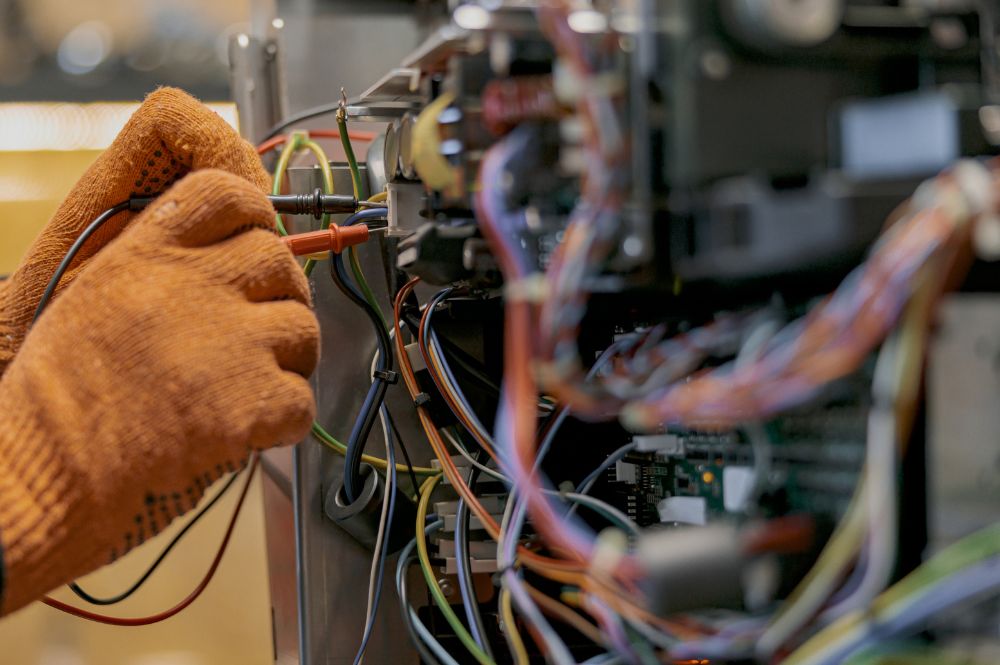Transforming Spaces with Sustainable Solutions: A Guide to Commercial Green Cleaning

Key Takeaways:
- Conventional cleaning agents contain toxic substances that harm the environment and human health.
- Green cleaning products improve indoor air quality and reduce health-related issues, especially for vulnerable populations.
- Adopting eco-friendly cleaning solutions can lead to long-term cost savings for businesses.
- Biodegradable cleaning ingredients break down naturally and can outperform traditional products.
- Certifications, such as EPA’s Safer Choice, help identify trustworthy eco-friendly products.
- Homemade cleaners using common kitchen ingredients offer effective, sustainable alternatives.
- Creating a sustainable cleaning schedule enhances cleanliness and promotes sustainability awareness.
- Training staff on green cleaning practices fosters a culture of sustainability within organizations.
- Measuring the success of green cleaning programs helps identify areas for improvement and confirms benefits.
- Green spaces contribute to employee well-being, productivity, and job satisfaction.
- Commitment to sustainability enhances brand image and attracts environmentally conscious customers.
- The future of commercial cleaning is driven by technological innovations that improve efficiency and sustainability.
Understanding the Fundamentals of Green Cleaning: Why It Matters
The Environmental Impact of Conventional Cleaning Agents
The chemical compounds found in conventional cleaning agents often include a range of toxic substances. These chemicals can persist in the environment for years, contributing to air and water pollution. For instance, phthalates and phosphates, common ingredients in many cleaning products, have been shown to disrupt ecosystems and endanger wildlife. When these products are washed down the drain, they can poison aquatic life and accumulate in waterways, leading to hazardous environmental conditions. Opting for commercial green cleaning solutions is crucial, not just as a personal choice but as a necessary step toward reducing our ecological footprint and helping preserve the planet for future generations.
Furthermore, volatile organic compounds (VOCs), which evaporate at room temperature and can contribute to air quality issues, are released into the atmosphere during the use and disposal of these cleaners. The resultant smog and pollution can aggravate respiratory issues in humans and harm plants and animals alike. This demonstrates the importance of transitioning to commercial green cleaning solutions, which significantly reduce harmful emissions and environmental impact.
Health Benefits of Switching to Green Cleaning
The health implications of conventional cleaning products extend beyond environmental concerns, directly impacting indoor air quality and human health. Numerous studies have linked the use of harsh cleaning chemicals to asthma, allergic reactions, and other respiratory problems. People—particularly those with pre-existing health conditions, children, and the elderly—are particularly vulnerable to these chemicals. Commercial green cleaning products, often formulated with naturally derived ingredients free from toxic chemicals, can help reduce the incidence of these health issues. By utilizing organic materials such as vinegar, baking soda, and essential oils, businesses can create a safer indoor environment.
Moreover, the use of non-toxic cleaning agents in commercial green cleaning can reduce workplace absenteeism, as employees experience fewer health-related issues, leading to enhanced productivity. Therefore, emphasizing a shift to green cleaning solutions not only results in a healthier work environment but supports a healthier workforce, making it a win-win scenario.
Cost-Effectiveness: Saving Green While Going Green
Contrary to popular belief, adopting a commercial green cleaning regimen can actually save money in the long run. While some eco-friendly products might initially have a higher price point, their concentrated formulas often require less product per cleaning session. In addition, the longevity of these products—fewer chemicals needed and less frequent purchases—can lead to significant savings over time. Additionally, the reduction of workplace health issues can translate to lower insurance costs and diminished expenses associated with employee sick days and turnover.
Sustainable practices, including resource conservation such as water savings from using efficient commercial green cleaning techniques and products, lead to a decrease in utility bills. As businesses strive for sustainability, they not only foster a positive brand image but also reap economic benefits. Thus, going green is not just an environmental imperative but a smart financial strategy for commercial enterprises.
Exploring Eco-Friendly Cleaning Products: What Makes Them Tick?
The Rise of Biodegradable Ingredients: Nature Meets Efficacy
As the concern for environmental sustainability heightens, the demand for biodegradable cleaning products has surged. Biodegradable ingredients break down naturally in the environment without leaving harmful residues. These products are derived from natural sources, such as plant materials, and processed without the use of aggressive industrial chemicals.
Additionally, they work effectively on a variety of surfaces, matching or even exceeding the performance of their traditional counterparts. Modern formulations harness the power of enzymes and natural surfactants, which can tackle tough stains and grease while being gentle on the planet. As sustainability goes mainstream, the market has seen a substantial increase in both the variety and availability of biodegradable products, enriching the cleaning landscape and allowing businesses to choose solutions that align with their environmental commitments.
Spotlight on Certifications: Trustworthy Labels to Look For
When it comes to selecting green cleaning products, discerning customers should be vigilant about certifications. Various organizations offer certifications that can guide consumers toward trustworthy eco-friendly products. For example, the U.S. Environmental Protection Agency’s (EPA) Safer Choice label signifies that a product meets stringent safety and environmental criteria. Certifications from Green Seal and the Cradle to Cradle Products Innovation Institute indicate that products have been evaluated for environmental impact and human health effects.
It is essential for businesses to educate their staff about these labels to ensure they are making informed purchasing decisions. With a myriad of products available, labeling allows consumers to navigate the landscape and choose conscious products that contribute to a sustainable future while ensuring quality cleaning performance.
Homemade Green Cleaners: Crafting Solutions from Your Kitchen
For those inclined to take sustainability into their own hands, creating homemade green cleaners offers a viable alternative to commercial products. Utilizing simple ingredients often found in kitchens—such as vinegar, baking soda, lemon juice, and essential oils—can yield effective cleaning solutions that are both eco-friendly and economical. For example, a mixture of vinegar and water serves as a natural disinfectant, while baking soda can tackle tough stains and odors. Lemon juice has antiseptic properties, making it a great addition to cleaning recipes, not to mention its refreshing scent.
The customization potential is endless; individuals can adjust the quantities and types of essential oils based on their preferences. Moreover, making these cleaners fosters awareness of what goes into the products you use daily, allowing for a greater connection to sustainable practices and contributing to a healthier home and workplace.
Implementing Green Cleaning Practices: A Step-by-Step Approach
Creating a Sustainable Cleaning Schedule for Your Workplace
Establishing a sustainable cleaning schedule is pivotal in implementing effective green cleaning practices. A well-planned schedule not only ensures that spaces remain clean and hygienic but also increases awareness of sustainability in operations. Businesses should assess the needs of their facilities, evaluating the frequency of cleanings required based on usage patterns and foot traffic.
Incorporating a checklist can help streamline tasks, ensuring that green cleaning products are used consistently throughout the facility. By designating specific tasks for certain days or times—for instance, deep cleaning common areas once a week while conducting daily spot cleaning—companies can balance thoroughness with efficiency. Furthermore, it is essential to periodically review and adjust the schedule based on seasonal needs or changes in occupancy. By keeping a clean, sustainable environment, companies can reinforce their commitment to green principles while optimizing resource use.
Training and Engaging Staff: Fostering a Green Culture
Education and engagement of staff are crucial in fostering a culture of sustainability within any organization. It begins with comprehensive training programs that educate employees about the importance of green cleaning initiatives, both for their health and for the planet. These training sessions could be complemented by hands-on demonstrations of how to use eco-friendly products effectively. Encouraging employees to get involved in the decision-making process regarding cleaning practices can also generate buy-in and increase morale. Employees often possess valuable insights that can aid in optimizing green cleaning efforts.
Businesses should facilitate open dialogues or feedback mechanisms where staff can share their experiences, preferences, and suggestions. Moreover, establishing “green teams” within workplaces to champion green initiatives provides an avenue for ongoing education and participation in sustainability efforts. By nurturing a sense of ownership and responsibility, organizations can cultivate not only more informed employees but also advocates for green practices within and beyond the workplace.
Measuring Success: Metrics to Evaluate Your Green Cleaning Program
Tracking the effectiveness of a green cleaning initiative is vital to ensure that goals are met and that practices continuously evolve. Organizations can employ various metrics to evaluate success, starting with the health and cleanliness of the workplace. Surveys and feedback mechanisms can be deployed to gauge employee satisfaction regarding air quality and general well-being.
Additionally, tracking costs related to cleaning supplies and labor can provide concrete data illustrating the economic impacts of switching to greener options. Another key performance indicator might involve monitoring reductions in complaints related to allergies or respiratory conditions among staff members. Organizations might also want to explore waste management metrics, measuring reductions in landfill waste through the adoption of refills and sustainable packaging solutions.
Ultimately, establishing a robust monitoring system enables businesses to celebrate successes, identify areas for improvement, and hone in on strategies that further their commitment to sustainability.
Beyond Cleaning: The Long-Term Benefits of Sustainable Practices
Enhancing Employee Well-being and Productivity through Green Spaces
The intersection of green cleaning practices and employee well-being cannot be overstated. Clean, naturally maintained environments foster better mental and physical health among employees, leading to higher productivity levels. Studies have demonstrated that increased exposure to cleaner air—including reduced VOCs and allergens—contributes to fewer sick days and absenteeism.
Furthermore, engaging employees in maintaining green spaces cultivates a connection to their work environment, fostering a positive workplace culture that prioritizes health and sustainability. The visualization of greenery in office spaces, such as plants and gardens, not only enhances aesthetics but also boosts mood and creativity, leading to enhanced problem-solving capabilities. Organizations that prioritize employee well-being and create greener workplaces often find they enjoy improved morale, higher retention rates, and an overall more engaged workforce.
Boosting Your Brand Image: Marketing Your Commitment to Sustainability
In today’s conscience-driven marketplace, consumers are increasingly discerning about the environmental and social implications of their purchasing decisions. Businesses that make a visible commitment to green cleaning practices can leverage this trend to enhance their brand image. A strong commitment to sustainability can attract environmentally conscious customers, create brand loyalty, and distinguish a company from its competitors. By craftily marketing sustainable practices—such as transparency in product sourcing, energy-efficient operations, and community engagement—companies can build a narrative that resonates with consumers.
Maintaining a presence on social media platforms and engaging in community initiatives can further amplify a business’s commitment to sustainability, encouraging positive word-of-mouth and enhancing customer relationships. In this manner, green cleaning extends beyond the physical space and becomes part of a larger story of corporate responsibility and ethical practices that bolster a company’s public image and ultimately, its bottom line.
The Future of Commercial Cleaning: Innovations on the Horizon
The momentum gained in green cleaning solutions is only the beginning. The future of commercial cleaning is poised to embrace technological innovations that enhance both efficiency and sustainability. Emerging trends include the use of smart technologies for monitoring cleanliness and resource consumption, minimizing waste while optimizing cleaning routines. Automated solutions, such as robotic cleaners or smart dispensers for cleaning solutions, will increasingly incorporate eco-friendly technologies designed to use less water and energy.
Moreover, as science and technology advance, we can expect to see the development of new biodegradable materials and green chemicals that promise improved efficacy without hazardous side effects. Innovations, like water ionization and environmentally safe fogging machines, showcase the evolution of the industry toward disruptive, sustainable methodologies. Ultimately, businesses that remain at the forefront of these advancements will not only be proactive in adhering to environmental regulations but also position themselves advantageously in a competitive market that prioritizes sustainability in every aspect of operations.





